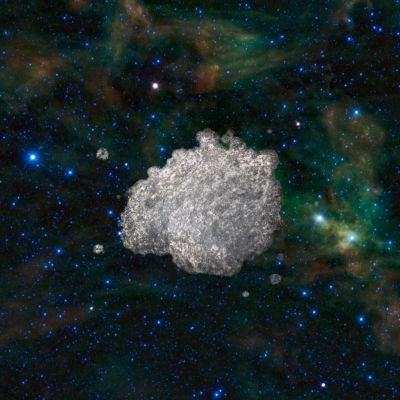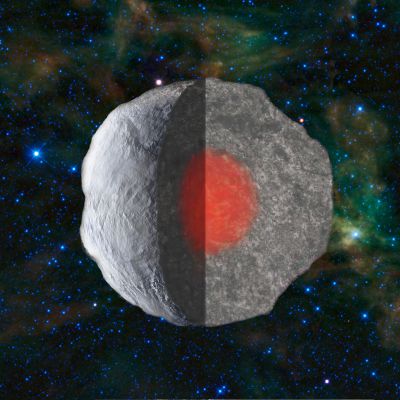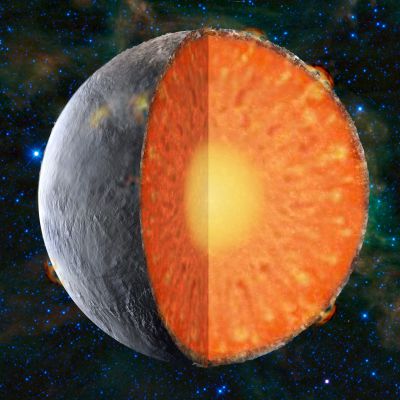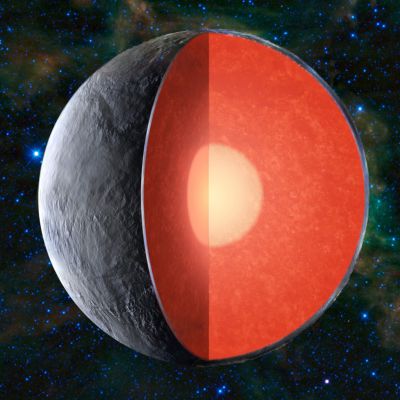The internal structure of rocky planets: a look at the Earth
An interior made up of different layers
You might think that the planets with a solid surface that are revolving around the Sun—like Mercury, Venus, the Earth or Mars—are homogeneous rocky globes, but they are not. If we could cut one of them in two with a giant planetary-scale knife, we would discover something rather like a peach. The first thin, velvety layer of a peach is its skin. If we keep cutting, we find a thicker layer of flesh surrounding a hard stone in the middle. The structure of telluric planets is not that different. The very thin surface layer is known as the crust. Underneath lies a much thicker, hotter layer known as the mantle. In the centre there is a core which can be solid, liquid, or both.
Obviously it is not possible to cut a planet in two like we can with fruit. So how do we know what is hidden deep within our planet? The deepest borehole on Earth, drilled in Russia’s Kola Peninsula, reached a respectable depth of 12,262 metres, or around 12 kilometres. However, the Earth’s average diameter is 12,742 kilometres! The Kola borehole only penetrated 0.2% of the Earth’s globe, and did not even manage to get through the continental crust, which is between 15 and 80 kilometres thick. Despite all our efforts, humans have only managed to slightly scratch the Earth’s surface.
However, geophysicists have a powerful investigation technique that has allowed them over several decades to explore the Earth’s interior and understand its structure. This technique is known as seismology.
Seismology, shedding light on the internal structure of a planet
Whenever a seismic wave changes compartment—for instance when it moves from the crust to the mantle, or from the mantle to the core—part of its energy is transferred from one compartment to the next (this part is known as the transmitted wave), while another part “bounces off” the boundary between them (this part is known as the reflected wave). The respective proportions of these two types of wave depend on the contrast in structure between the two compartments, and are used to identify their boundaries, or “interfaces”.
Likewise, if there are any discontinuities within a given compartment, i.e. if the compartment is not completely uniform, the seismic waves will be similarly affected. Again, geophysicists can determine the structure of a given compartment. They may, for example, reveal stratifications within the crust or anomalies in the mantle. Today, the progress made in geophysics on Earth has been so great that we can now acquire images of the planet’s interior, rather like ultrasound scans.
The Earth’s internal structure
By observing over the decades how seismic waves naturally generated by earthquakes are propagated through the planet, geophysicists first discovered the existence of the three main envelopes mentioned above: the crust, the mantle and the core. They went on to obtain a very detailed view of the Earth’s interior.
At the surface lies the crust, which may be oceanic or continental. The oceanic crust, mainly composed of basalt rock overlaid by sediments forming the ocean floor, is relatively thin, averaging some 6 to 11 kilometres. However, the continental crust—which forms the skeleton of land masses—is made of granite and is much thicker, ranging from 15 to 80 kilometres under mountain ranges, though the average is 30 kilometres.
Next comes the mantle, which is separated from the crust by a discontinuity discovered in 1909 by Andrija Mohorovicic, a pioneer of seismology. Indeed, the discontinuity is now commonly known as the Moho in his honour. The Earth’s mantle is an invisible yet immense portion of the Earth in terms of volume, because it extends downwards some 2,900 kilometres before meeting the core. It comprises two distinct regions: the upper mantle, which is up to 660 kilometres deep, and the lower mantle, even deeper.
The upper mantle is itself divided into two compartments: a solid, brittle part attached to the crust and forming with it the famous moving lithospheric (or “tectonic”) plates, and a malleable part extending down as far as the lower mantle and able to be deformed. Composed of olivine-rich rocks, the Earth’s upper mantle moves under the influence of convection, participating in the movement of the lithospheric plates it carries on its back.
In the lower mantle, pressure and temperature—which increase with depth—cause modifications in the crystalline structure of minerals that geophysicists call a phase change. One of the biggest phase changes occurs at a depth of 670 kilometres, defined as the limit between the upper and the lower mantle. Here, the olivine becomes denser, transforming into perovskite. This change has major consequences, especially on viscosity, which is a parameter that greatly influences the ease with which matter can move (water, for example, has almost no viscosity compared to honey, which does not flow so easily but still remains more fluid than toothpaste).
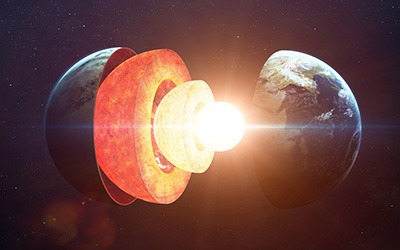 The Earth’s internal structure: our planet is divided up into three envelopes: the crust, the mantle and the core. The Earth’s core is liquid on the outside (the outer core) and solid on the inside (the inner core) (© Adobe Stock).
The Earth’s internal structure: our planet is divided up into three envelopes: the crust, the mantle and the core. The Earth’s core is liquid on the outside (the outer core) and solid on the inside (the inner core) (© Adobe Stock).
Below the mantle is the core, separated from the mantle by the Gutenberg discontinuity. With an average radius of 3,470 kilometres, the core is also composed of two parts. The outer, liquid, part extends between 2,900 and 5,100 kilometres deep, where the Lehmann discontinuity lies. This boundary separates the liquid outer core from the solid inner core, which is what really lies at the heart of our planet, some 5,100 to 6,371 kilometres below the surface.
Formation of the planet’s internal structure: accretion and differentiation
To better understand the composition and properties of the compartments making up planets, we need to go back to the way they are formed. They acquire their internal structure very early on, during a process known as differentiation, certain aspects of which remain a mystery.
Our solar system, which includes the Sun and the procession of planets orbiting around it, was born some 4.5 billion years ago following the collapse of a huge interstellar cloud of gas and dust. The Sun (which is a star) held centre stage while planets formed around the edges, within the limits of an accretion disk
An accretion disk may be compared to a kind of infernal cauldron from which planets emerge. It is composed of a mixture of gases in which lumps of matter, metal, rock and ice are moving in all directions. The numerous collisions that take place cause some lumps to get bigger, while others are pulverised into smaller particles.
Due to their greater gravitational pull, the biggest fragments are more likely to attract other lumps, thus increasing their size and consequently their power of attraction. Each of these big fragments ends up forming what planetary scientists call a “planetesimal”, which is a kind of huge asteroid. Planetesimals are the building blocks in the formation of planets. Still subject to incessant collisions within the accretion disk, these planetesimals aggregate to form protoplanets. Around the young star we know as the Sun, balls of white-hot matter appeared. One of these was our planet, Earth, and another was Mars.
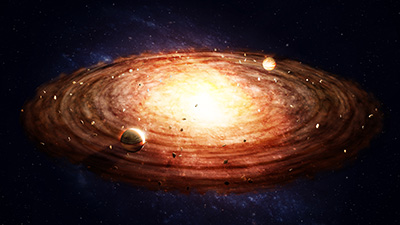 Artist's concept of the accretion process (© Adobe Stock).
Artist's concept of the accretion process (© Adobe Stock).
Both on the surface and deeper within, the temperatures involved in the formation of planets are so hot that most of the materials participating in the aggregation of the planet’s body melt. Metals become liquid, rocks become boiling magma and lighter, more volatile elements such as water dissipate into space as burning vapours, being unable to aggregate or remain in the same place.
It is at this stage that the process known as differentiation takes place. Differentiation is fundamental to the planet’s future, because by the end of this process, the body has acquired its internal structure, which is what determines its evolution.
The various elements making up the planet are separated during the differentiation process according to their nature. Iron, of which telluric planets contain a significant quantity, descends into the centre of the planet because of its weight, taking with it other elements such as nickel and sulphur to create a metal core.
Silicates (the main component of rocks) are compounds lighter than metals. They combine with other atoms such as sodium or potassium to form a rocky froth that remains on the surface, becoming a thin stable layer as it cools down. This is the crust.
Between the crust and the core there remains a fairly thick envelope composed of silicates that this time combine with elements such as magnesium and iron to form the mantle.
Finally, very volatile gaseous elements escape through the fissures in the crust and gather around the planet, creating an atmosphere of varying thickness and possibly, if the pressure and temperature conditions are conducive, layers of water (in ice and/or liquid form). The planet can only keep its atmosphere around it if its mass—and thus its gravitational pull—is sufficient. If it is not, the atmosphere can easily and irreversibly dissipate into space.
The differentiation process is similar to what happens in a blast furnace filled with ores in order to extract pure metals. Let us take the example of a blast furnace near an iron mine. The furnace chamber is filled with iron ore made up of iron oxides and other impurities and coke, which is a kind of coal. Everything is heated up to temperatures allowing the mixture to melt. The pure iron that emerges when the mixture melts accumulates at the bottom of the crucible due to its weight, forming cast iron in much the same way as the formation of the planet's core. Silicates being lighter than iron, they form a kind of frothy scum that stays on the surface. This “slag”, as it is known, resembles the crust. Finally, gases whistle as they escape upwards, like those of the atmosphere.
A planet’s internal structure determines its future evolution
After the differentiation process, a telluric planet is composed of a core, a mantle, a crust and, possibly, water layers and an atmosphere. These main envelopes are absolutely fundamental, because together they determine the planet’s future. It is thanks to the Earth’s interior that it is still a living planet, both from a geological and biological point of view, after 4.5 billion years of existence.
The Earth’s geological activity is both varied and intense. Volcanoes scattered over the globe spit out huge lava flows and clouds of ash; earthquakes shake towns and their inhabitants; some mountains continue to rise, while others are worn down by erosion and end up as grains of sand on a beach.
Plate tectonics
The Earth’s unrestrained geological vitality is related to an imperceptible but crucial phenomenon known as plate tectonics.
Very early in our planet’s history, the intense convective activity in the mantle broke the planet’s surface up into some ten huge lithospheric plates, which have ever since been moving away from, colliding with or even slipping under each other with differing degrees of friction. It is the rough sliding of plates that causes earthquakes. When plates move away from each other, the indents left are filled by seas and oceans, and when these same plates finally close together like jaws then end up colliding, these same seas and oceans disappear, leaving scar tissue in the form of mountain ranges.
Over very long time periods (hundreds of millions of years), plate tectonics has had a quite astonishing consequence: the appearance of long-period phenomena known as Wilson cycles. During one of these cycles, the land masses grouped into one “supercontinent” surrounded by an enormous ocean. Pulled on all sides, the supercontinent was finally torn apart into a multitude of moving parts that spread throughout the planet before inevitably coming back together and finally merging. This large-scale geological ballet—which is constantly changing, slowly but surely, the face of the planet—is being played out again and again on the world stage.
Thus, contrary to what you might think, today’s global maps—drawn up following much exploration—are just a snapshot of the Earth’s life. On the scale of Wilson cycles, our geographical maps are only valid for a brief moment. The Earth looked very different hundreds of millions of years ago, and in the distant future, the boundaries of oceans and continents will not look anything like they do today.
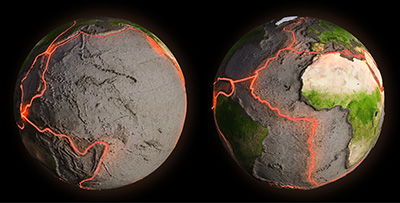 Plate tectonics bears witness to the Earth’s constant geological activity (© Adobe Stock).
Plate tectonics bears witness to the Earth’s constant geological activity (© Adobe Stock).
Yet plate tectonics has other even greater consequences. Its existence has given the Earth two types of crust, mentioned earlier: the oceanic crust which supports the oceans and which is relatively thin, and the thicker continental crust upon which we live. Even if it is only a hypothesis, it is likely that life could not develop and evolve in the same way on an ocean-covered planet (without continents) or a land-covered planet (without any liquid surface). Earth is lucky enough to have both land and oceans, a feature that has no doubt played a significant role in its ability to host and foster the development of life.
Likewise, in the subduction zones where plates are driven downwards into the Earth’s interior, the process of plate tectonics allows a recycling of volatile elements, and especially water. This element lowers the temperature at which rocks melt, so the constant cycle of water between the inner and outer parts of the planet appears vital to maintaining volcanic activity.
Volcanic activity, which on Earth is mainly linked to plate tectonics (virtually all volcanoes being found along the boundaries of lithospheric plates), is one of the features that has allowed our planet to retain its atmosphere. This gaseous layer is directly responsible for surface temperatures. Depending on its thickness and composition, and especially the presence of greenhouse gases that can retain heat, a planet’s atmosphere determines temperatures on the ground. If there is no gaseous layer or if it is too thin, the planet will be very cold, like the Moon or Mars. If it is too thick, it can transform the world into a suffocating inferno like Venus. Again, there is a marked correlation with the Earth’s ability to harbour life.
Everything appears to indicate that if the mechanism of plate tectonics had never occurred on Earth, our world would be very different from what it is today, and it is very likely that we would not even be here to talk about it.
The Earth’s magnetic field protects it from cosmic dangers
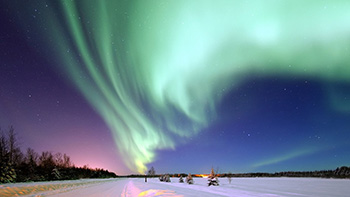 Aurora borealis on Earth: at the poles, the energetic particles in the solar wind excite the Earth’s atmosphere, creating magnificent light shows (© Creative Commons).The geological vigour of a planet also fuels another phenomenon crucial to all life forms. Deep in the bowels of the Earth, molten metal is subject to complex convective motions that create a global magnetic field.
Aurora borealis on Earth: at the poles, the energetic particles in the solar wind excite the Earth’s atmosphere, creating magnificent light shows (© Creative Commons).The geological vigour of a planet also fuels another phenomenon crucial to all life forms. Deep in the bowels of the Earth, molten metal is subject to complex convective motions that create a global magnetic field.
Completely invisible unless you have a compass or are lucky enough to witness the northern lights, this magnetic field surrounds the planet with an invisible web of lines of force, and enables us to carry on with our lives without worrying about unsuspected cosmic dangers.
The Earth’s magnetic field acts as a shield, deflecting high-energy particles from the Sun or from the depths of our galaxy, the Milky Way. If these particles were not deflected by a magnetic field, this abrasive radiation could easily “shred” the atmosphere, wearing it down to such a point that it could actually disappear into space. The particles could also cause major damage to any life forms on the Earth’s surface.
Understanding the fate of Mars
Learning about the internal structure of Mars might appear to be a purely academic exercise, at least until we compare the Red Planet to Earth.
When we compare the two bodies, we are bound to be struck by their different fates, despite both of them starting off with the same potential. As already seen, some 4.5 billion years ago, Mars and Earth were formed within a near-identical sector of the accretion disk. As a first approximation, the two planets were assembled in the same conditions and from the same stock of building materials.
A true paradise within the hostile, frozen depths of the universe, Earth was able to host life and nurture its development over several billion years. In comparison, the image we have of the Red Planet today is both troubling and intimidating. Mars no longer has any magnetic field, and with an atmospheric pressure almost 200 times lower than Earth’s, the thin layer of air surrounding the planet cannot do much about heating up the surface. On the ground, conditions are glacial, with a mean temperature of -53°C.
While the majestic volcanic structures on Mars remind us of its glorious past, all of them appear to be extinct now. None of the rovers has come across the tiniest dribble of lava or slightest hydrothermal activity. Finally, if the process of plate tectonics began shortly after the planet’s creation—a subject of much debate among experts—it stopped shortly after, and the Martian lithosphere is not broken up into moving plates like the Earth’s, but forms a single very thick, rocky shell under which lies the mantle and core.
Why such differences? Why did Mars, which had the potential to become a second Earth and host the origins of life, become a desolate, barren planet? The answer lies in the depths of Mars, and it is up to the InSight probe to find it.




